The Cessna 172SP POH is an essential guide for pilots, providing detailed information on aircraft operation, performance, and safety procedures․ It is an FAA-approved manual․
1․1 Overview of the POH
The Cessna 172SP POH is a comprehensive guide detailing the aircraft’s operational procedures, performance characteristics, and safety protocols․ It is divided into nine sections, covering essential information for pilots, from pre-flight checks to emergency procedures․ The manual is FAA-approved and serves as the primary reference for safe and efficient aircraft operation․ It includes both mandatory and supplementary data, ensuring pilots have all necessary information to maximize the airplane’s utility and safety․ This handbook is a critical resource for every Cessna 172SP pilot․
1․2 Importance of the POH for Safe Flight Operations
The POH is an essential guide for ensuring safe and efficient flight operations․ It provides critical information on aircraft performance, operating limits, and emergency procedures․ Adhering to the POH ensures compliance with FAA regulations and promotes standardized procedures․ Pilots must carry the POH in the aircraft at all times, as it serves as the primary reference for decision-making during all phases of flight․ Its guidelines are crucial for minimizing risks and maximizing safety in various flight conditions․
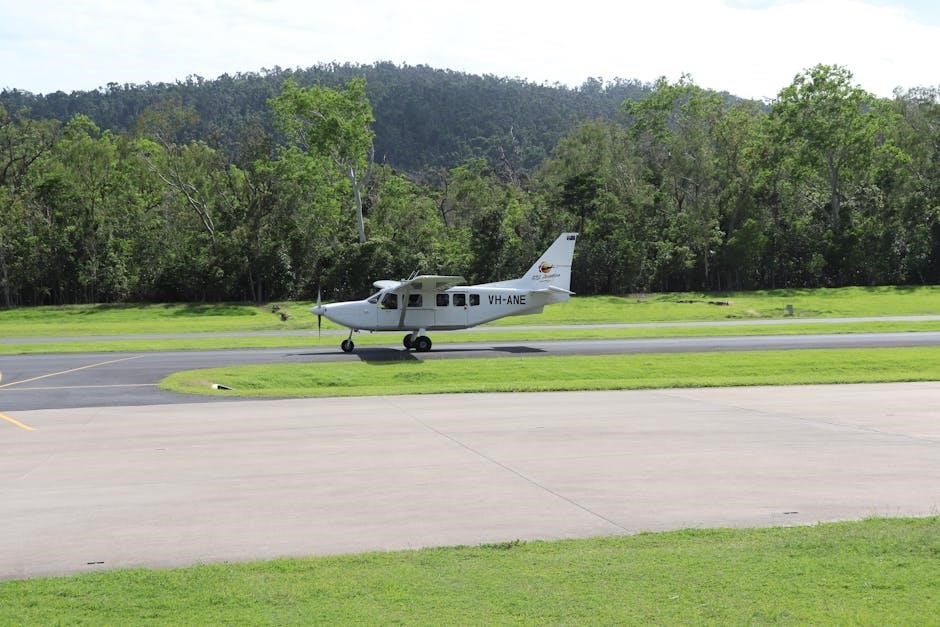
Aircraft Overview
The Cessna 172SP is a single-engine, four-seat aircraft known for its reliability and ease of handling․ It is widely used for flight training and personal flying․
2․1 Key Features of the Cessna 172SP
The Cessna 172SP features a robust Lycoming IO-360-L2A engine, producing 180 HP, and a constant-speed propeller for optimal performance․ It includes the advanced KAP 140 autopilot system, enhancing flight stability and reducing pilot workload․ The aircraft boasts a modern 3D cockpit design with a G1000 NXi avionics suite, offering precise navigation and real-time data․ Additional features include improved lighting, ergonomic controls, and noise reduction measures for a comfortable flying experience, as detailed in the POH․
2․2 Serial Number and Model Identification
The Cessna 172SP aircraft’s serial number is crucial for identification and documentation․ Serial numbers like 17258001 are specific to each model, as detailed in the POH․ The model identification ensures compliance with FAA regulations and maintenance requirements․ This information is typically located on the aircraft’s data plate and is essential for verifying the plane’s certification and configuration․ The POH covers the Cessna Model 172S NAV III, including the KAP 140 autopilot system, ensuring accurate operational guidelines for pilots․

Flight Instruments and Controls
The Cessna 172SP features a comprehensive suite of primary flight instruments and avionics, including the KAP 140 autopilot system, designed for precise navigation and flight control․
3․1 Primary Flight Instruments
The Cessna 172SP is equipped with essential primary flight instruments, including the airspeed indicator, attitude indicator, heading indicator, altimeter, and turn coordinator․ These instruments provide critical data for monitoring aircraft performance and orientation during flight․ The airspeed indicator shows speed, the attitude indicator displays pitch and roll, while the heading indicator offers directional information․ The altimeter provides altitude readings, and the turn coordinator aids in maintaining balanced turns․ Together, these instruments ensure precise control and situational awareness for safe and efficient flight operations․
3․2 Avionics and Navigation Systems (e․g․, KAP 140 Autopilot)
The Cessna 172SP features advanced avionics, including the KAP 140 autopilot system, which simplifies flight operations by automating altitude, heading, and navigation tasks․ The system integrates with GPS and VOR navigation, enabling precise course tracking and altitude maintenance․ Additional avionics include a digital audio panel, NAV/COM radios, and a transponder, ensuring efficient communication and navigation․ These systems enhance situational awareness, reduce pilot workload, and contribute to safer and more efficient flight operations․
Performance Characteristics
The Cessna 172SP delivers exceptional performance with a maximum speed of 140 knots and a service ceiling of 13,500 feet, ensuring efficient flight operations․
4․1 Speed and Altitude Limits
The Cessna 172SP has a maximum speed of 140 knots (161 mph) and a cruise speed of 122 knots (140 mph) at 8,000 feet․ The service ceiling is 13,500 feet, with a rate of climb at sea level of 730 fpm․ Stall speed at gross weight is 47 knots (55 mph) with flaps extended․ These limits ensure safe and efficient flight operations, as outlined in the POH․ Pilots must adhere to these specifications for optimal performance and safety․
4․2 Fuel Capacity and Range
The Cessna 172SP has a fuel capacity of 53 gallons, enabling a maximum range of approximately 840 nautical miles․ At optimal altitude (8,000 ft) and power settings, the aircraft achieves a fuel flow of 9․5 gallons per hour, allowing endurance of about 6 hours․ These specifications ensure efficient long-distance flights while adhering to safety and performance guidelines outlined in the POH․ Proper fuel management is critical for achieving the stated range and performance characteristics․
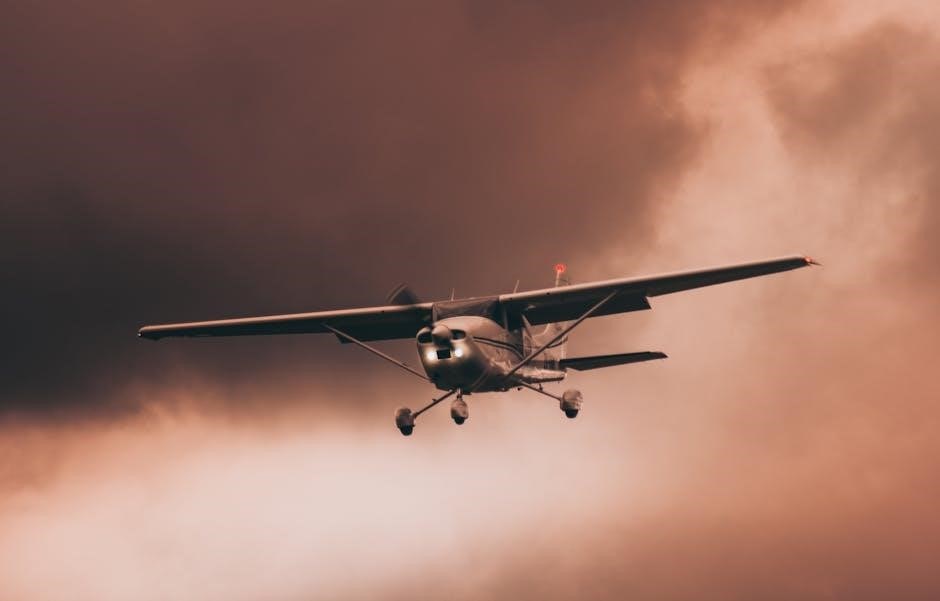
Operating Procedures
The Cessna 172SP POH provides detailed procedures for pre-flight checks, takeoff, landing, and emergency situations․ It ensures safe and efficient aircraft operation under various conditions, adhering to FAA guidelines․
5․1 Pre-Flight Checklist
The pre-flight checklist in the Cessna 172SP POH is a critical step to ensure safe and efficient flight operations․ It includes exterior inspections, control lock verification, and fuel checks․ Pilots must confirm proper function of all systems, including navigation and communication equipment․ The checklist also covers cabin preparation, seatbelt checks, and emergency equipment availability․ Adhering to this structured process helps prevent oversights and ensures compliance with safety standards outlined in the POH․ A thorough pre-flight routine is essential for a successful and safe flight․
5․2 Takeoff and Landing Techniques
The Cessna 172SP POH provides detailed procedures for takeoffs and landings, emphasizing smooth control inputs and proper airspeed management․ For takeoffs, pilots are advised to advance the throttle gradually and maintain a steady climb angle․ During landings, a stabilized approach is crucial, with specific flare techniques to minimize floating․ The POH also covers special scenarios, such as short-field or soft-field operations, ensuring safe and controlled touchdowns․ Proper technique adherence is vital for optimal aircraft performance and safety․
5․3 Emergency Procedures
The Cessna 172SP POH outlines critical emergency procedures to ensure pilot preparedness․ It covers engine failure, system malfunctions, and fire emergencies, providing step-by-step actions․ Pilots are instructed to remain calm, secure the engine if necessary, and declare an emergency if required․ The manual emphasizes proper communication and post-incident checks․ Adherence to these procedures is essential for minimizing risks and ensuring safe outcomes․ The POH also includes guidelines for handling unexpected situations, reinforcing pilot training and decision-making under pressure․
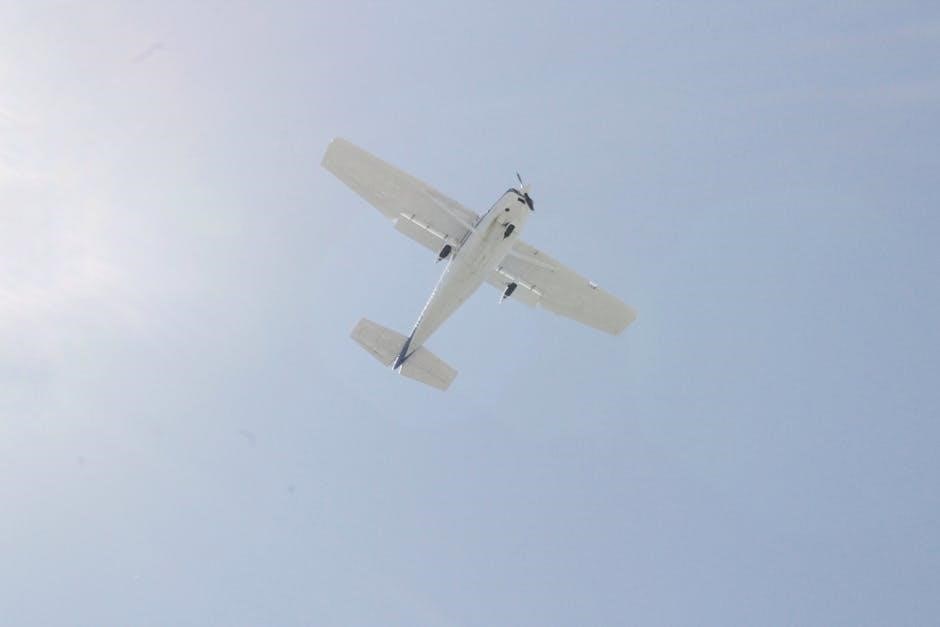
Safety Features and Emergency Equipment
The Cessna 172SP is equipped with essential safety features, including fire extinguishers, emergency exits, and communication systems․ These tools enhance pilot and passenger safety during critical situations․
6․1 Fire Extinguisher and Other Safety Devices
The Cessna 172SP is equipped with a fire extinguisher located near the pilot’s seat for quick access․ Additional safety devices include emergency exits, oxygen systems, and first aid kits․ These are designed to ensure pilot and passenger safety during emergencies․ Regular inspections and maintenance are required to ensure functionality․ Proper usage is detailed in the POH to guide pilots in critical situations effectively․
6․2 Emergency Communication Systems
The Cessna 172SP features a COM radio and transponder for emergency communication․ The KAP 140 autopilot integrates with these systems, enabling quick access to emergency frequencies like 121․5 MHz․ These tools allow pilots to contact air traffic control or nearby aircraft in critical situations․ Proper usage of these systems is detailed in the POH to ensure effective communication during emergencies, enhancing overall flight safety and compliance with aviation regulations․
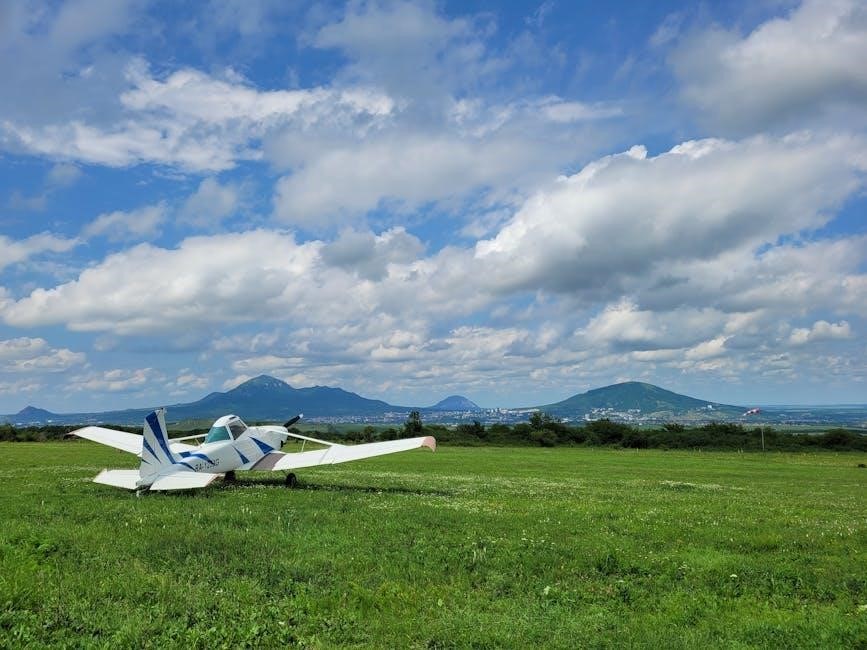
Maintenance and Inspection Requirements
The POH outlines scheduled maintenance intervals and inspection procedures to ensure the Cessna 172SP remains airworthy․ Regular checks and compliance with these guidelines are mandatory for safety․
7․1 Scheduled Maintenance Intervals
The Cessna 172SP POH specifies regular maintenance intervals to ensure aircraft airworthiness․ Oil changes are required every 50 hours, and annual inspections must be conducted by certified mechanics․ Compliance with FAR Part 23 regulations is mandatory․ The manual outlines detailed schedules for engine, propeller, and airframe inspections․ Adherence to these intervals ensures optimal performance, safety, and longevity of the aircraft․ Proper documentation of all maintenance activities is also emphasized to maintain compliance and operational readiness․
7․2 Pilot Responsibilities for Pre- and Post-Flight Inspections
Pilots must conduct thorough pre- and post-flight inspections to ensure the Cessna 172SP is airworthy․ Pre-flight checks include verifying control surfaces, tire condition, and fuel levels․ Post-flight inspections involve securing the aircraft and documenting any discrepancies․ The POH emphasizes compliance with FAA guidelines and prompt reporting of maintenance issues․ These responsibilities are critical for maintaining safety and extending the aircraft’s operational life․ Adherence to these protocols ensures compliance with regulatory standards and promotes safe flight operations․

Regulatory Compliance
The Cessna 172SP is FAA-certified and complies with FAR Part 23․ The POH provides necessary information for regulatory compliance, ensuring safe and legal flight operations․
8․1 FAA Approval and Certification
The Cessna 172SP has received official FAA certification, meeting rigorous safety and performance standards․ Its Pilots Operating Handbook is an approved flight manual, ensuring compliance with federal aviation regulations․ This certification validates the aircraft’s airworthiness and reliability, allowing it to operate legally within U․S․ airspace․ The manual incorporates all necessary guidelines and updates, making it a critical resource for pilots to adhere to FAA requirements and maintain safe flight practices․
8․2 Compliance with FAR Part 23
The Cessna 172SP fully complies with FAR Part 23, which governs airworthiness standards for small aircraft․ This regulation ensures the aircraft meets strict design, performance, and safety requirements․ Compliance involves rigorous testing and verification of systems, materials, and operational limits․ The POH outlines these standards, providing pilots with essential information to operate the aircraft safely and legally under federal aviation regulations․ This compliance ensures reliability and safety for pilots and passengers alike․
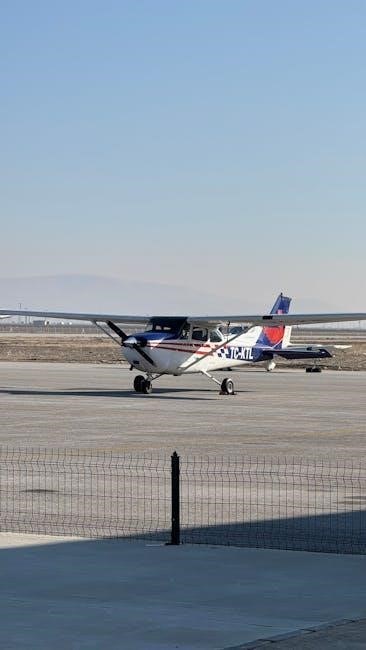
Supplementary Data and Resources
The Cessna 172SP POH includes supplementary data such as conversion tables, charts, and additional reference materials․ Online resources like PDF downloads are also available for pilot convenience․
9․1 Additional Reference Materials
Section 9․1 provides supplementary guides and resources for the Cessna 172SP, including conversion tables, charts, and additional reference materials․ These resources aid pilots in understanding complex calculations and operational procedures․ Supplementary materials are available online, such as PDF downloads, ensuring pilots have access to updated information․ These resources complement the POH, offering detailed insights for training and operational purposes․ They are essential for pilots seeking to enhance their knowledge and proficiency in flying the aircraft safely and efficiently․
9․2 Online Resources for the Cessna 172SP POH
Online resources for the Cessna 172SP POH include downloadable PDF versions available on platforms like Dropbox and Scribd․ These resources provide easy access to the manual, ensuring pilots can review procedures anytime․ Additional materials, such as flight manuals and guides, are also available for reference․ Online forums and aviation websites offer discussions and updates related to the POH, helping pilots stay informed․ These resources are invaluable for both training and operational needs, supporting safe and efficient flight operations․

Appendices and Glossary
The appendices provide conversion tables, charts, and additional reference materials․ The glossary defines key terms and abbreviations, ensuring clarity for pilots using the Cessna 172SP POH․
10․1 Abbreviations and Definitions
This section provides a comprehensive list of abbreviations and definitions used throughout the POH․ It ensures pilots understand technical terms, enhancing safe and efficient aircraft operation․ Common abbreviations include IAS (Indicated Airspeed) and VFR (Visual Flight Rules)․ Definitions clarify complex concepts, making the manual accessible to all users․ This section is crucial for interpreting performance data, safety procedures, and regulatory compliance, ensuring accurate communication and consistent application of operational standards;
10․2 Conversion Tables and Charts
This section includes conversion tables and charts essential for pilots to interpret aircraft performance data․ It covers units of measurement, such as fuel capacity (gallons to liters) and weight (pounds to kilograms)․ Additionally, it provides altitude, airspeed, and temperature conversions․ These tools are critical for pre-flight planning and in-flight adjustments, ensuring accurate calculations․ Examples include converting inches of mercury to millibars and Fahrenheit to Celsius․ This section enhances pilots’ ability to understand and apply performance data effectively․